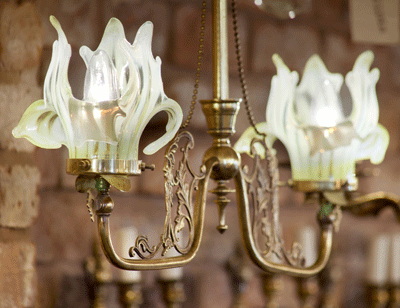Gas Lighting in Victorian times
The Victorians were pleased to be able to control gas more than the wax candles of Georgian times, although it wasn’t always the safest method of lighting the house

Now don't get me wrong, there's a lot to be said for gas lighting (not least the stunning fittings which survive from the wealthy middle classes) but I question whether it would pass today's health and safety requirements.
During the Victorian era, major improvements in the fields of science and engineering led to a huge expansion in industry. Having previously been restricted to candle and firelight, the effect of introducing a ‘controllable' light source to society was enormous. Factories, streets, shops and, eventually, houses could now be lit on a scale previously unimaginable; extending the number of working hours in a day.
Experiments with gas began in the eighteenth century, but William Murdoch was the first to use gas on a large scale, when he lit his house and office in Cornwall and, later, his employer's (Boulton & Watt) works. However, it was Albert Winsor who formed the Gas Light and Coke Company, which became the largest gas company in the world. His success came despite, or maybe because of, some rather ludicrous initial claims; such as his claim that a room full of gas when entered with a candle ‘Will never inflame because it is intermixed with the air of the room' and that gas was ‘more congenial to our lungs than vital air'.

Now for the dangerous bit... There were two types of gas used in Victorian times ‘coal' and natural gas. Coal gas included a rather lethal combination of hydrogen, methane, carbon monoxide and sulphur. Not only is this a highly flammable composition, but the occupants of any building with poor ventilation ran the risk of carbon monoxide suffocation.
* Subscribe to Country Life and up to £50
As the popularity of gas grew and supplies expanded into homes the industry soon became very cut throat. A lack of regulation meant firms cut corners and tried to sabotage their competition. Low pressure was a common problem for consumers, caused by the numerous fractures of pipes and joints due to poor workmanship, accident or sabotage. However, rather more concerning, were the increased reports of fires, explosions and suffocations. The image of a Victorian lady fainting is as likely to be due to lack of oxygen caused by gas lighting as an overly tight corset.

The Victorian passion for design and decoration led to the creation of some stunning and imaginative gasoliers (chandeliers powered by gas) and gas wall brackets, often adorned with beautiful glass shades. However, they suffered obvious drawbacks with large flames leaping from them, doubly risky given the Victorian passion for copious drapes and a lack of fire retardant fabric! The impure gas of the Victorian era also gave off a nasty smell, blackened walls and ceilings and tarnished metal due to the sulphuric acid given off.
Exquisite houses, the beauty of Nature, and how to get the most from your life, straight to your inbox.
Despite its many drawbacks, gas remained the most popular form of lighting until the launch of the National Grid in the 1930s and the history of lighting would be much duller without it.
Karen Wallis-Smith, owns Fritz Fryer Antique Lighting who offer an extensive lighting sales, design and consultancy service, specialising in the high quality restoration of period fittings. They also work with private and commercial clients to create sympathetic lighting solutions for period properties and their on-site workshop repair all fittings, by hand, to the highest possible standard.

This is an article from ProjectBook which provides a wide range of information for the conservation, restoration, care and repair of period and listed buildings. Fritz Fryer Antique Lighting is a member of the Heritage Register which contains over 500 vetted craftsmen, contractors and consultants from all over the UK. Updated daily with new content, the website features the heritage register, a products directory, informative articles, current news, events and more. For more information, visit www.projectbook.co.uk.
Country Life is unlike any other magazine: the only glossy weekly on the newsstand and the only magazine that has been guest-edited by His Majesty The King not once, but twice. It is a celebration of modern rural life and all its diverse joys and pleasures — that was first published in Queen Victoria's Diamond Jubilee year. Our eclectic mixture of witty and informative content — from the most up-to-date property news and commentary and a coveted glimpse inside some of the UK's best houses and gardens, to gardening, the arts and interior design, written by experts in their field — still cannot be found in print or online, anywhere else.

